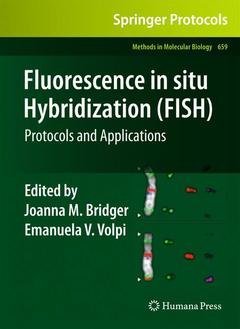Description
Fluorescence in situ Hybridization (FISH), Softcover reprint of the original 1st ed. 2010
Protocols and Applications
Methods in Molecular Biology Series, Vol. 659
Language: English
Subject for Fluorescence in situ Hybridization (FISH):
Approximative price 116.04 €
Subject to availability at the publisher.
Add to cart
Fluorescence in situ Hybridization (FISH)
Support: Print on demand
Support: Print on demand
Fluorescence in situ hybridization (FISH): protocols & applications (Methods in molecular biology, Vol. 659)
451 p. · 17.8x25.4 cm · Hardback
451 p. · 17.8x25.4 cm · Hardback
Description
/li>Contents
/li>Comment
/li>
Fluorescence in situ Hybridization (FISH) belongs to that special category of well-established molecular biology techniques that, since their inception a few decades ago, have succeeded in keeping a prominent position within the constantly expanding list of laboratory pro- dures for biomedical research and clinical diagnostics. The design simplicity and cost-effectiveness of the early FISH protocols, combined with the signifcant acceleration of discoveries in related technical areas such as fuor- cence microscopy, digital imaging, and nucleic acid technology have prompted the div- sifcation of the original technique into an outstanding number of imaginative and useful applications, and thus have not only held back its outmoding but have also promoted its expansion into different areas of basic and applied research in the post-genomic era. The 34 chapters included in this book aim at portraying the vibrant complexity and diversity of the current FISH protocol landscape, providing cutting-edge examples of va- ous applications for genetic and developmental research, cancer research, reproductive medicine, diagnostic and prognostic purposes, microbial ecology, and evolutionary st- ies. The book is divided in four parts: (I) Core Techniques, (II) Technical Advancements and Novel Adaptations, (III) Translational FISH: Applications for Human Genetics and Medicine, and (IV) Protocols for Model Organisms.
Core Techniques.- Fluorescence in situ Hybridization (FISH), Basic Principles and Methodology.- Fluorescence In Situ Hybridization on DNA Halo Preparations and Extended Chromatin Fibres.- Detection of Nascent RNA Transcripts by Fluorescence In Situ Hybridization.- Fluorescence In Situ Hybridization Analysis of Formalin Fixed Paraffin Embedded Tissues, Including Tissue Microarrays.- Fluorescence in situ Hybridization (FISH) on Tissue Cryosections.- Multiplex Fluorescence in situ Hybridization (M-FISH).- Optical Mapping of Protein–DNA Complexes on Chromatin Fibers.- 3D-FISH on Cultured Cells Combined with Immunostaining.- Technical Advancements and Novel Adaptations.- The Comet-FISH Assay for the Analysis of DNA Damage and Repair.- Direct In Situ Hybridization with Oligonucleotide Functionalized Quantum Dot Probes.- LNA-FISH for Detection of MicroRNAs in Frozen Sections.- Chromosome Orientation Fluorescence In Situ Hybridization or Strand-Specific FISH.- Combinatorial Oligo FISH: Directed Labeling of Specific Genome Domains in Differentially Fixed Cell Material and Live Cells.- Simultaneous Visualization of FISH Signals and Bromo-deoxyuridine Incorporation by Formamide-Free DNA Denaturation.- CryoFISH: Fluorescence In Situ Hybridization on Ultrathin Cryosections.- Characterization of Chromosomal Rearrangements Using Multicolor-Banding (MCB/m-band).- Visualizing Nucleic Acids in Living Cells by Fluorescence In Vivo Hybridization.- Translational FISH: Applications for Human Genetics and Medicine.- Quality Control in FISH as Part of a Laboratory’s Quality Management System.- FlashFISH: “Same Day” Prenatal Diagnosis of Common Chromosomal Aneuploidies.- FISH for Pre-implantation Genetic Diagnosis.- PNA–FISH on Human Sperm.- POD-FISH: A New Technique for ParentalOrigin Determination Based on Copy Number Variation Polymorphism.- Sequence-Based High Resolution Chromosomal Comparative Genomic Hybridization (CGH).- ImmunoFISH on Isolated Nuclei from Paraffin-Embedded Biopsy Material.- Fluorescence In Situ Hybridization on 3D Cultures of Tumor Cells.- Simultaneous Ultrasensitive Subpopulation Staining/Hybridization In Situ (SUSHI) in HIV-1 Disease Monitoring.- Protocols for Model Organisms.- Detection of Prokaryotic Cells with Fluorescence In Situ Hybridization.- FISH as a Tool to Investigate Chromosome Behavior in Budding Yeast.- FISH on Chromosomes Derived from the Snail Model Organism Biomphalaria glabrata.- Fluorescence in situ Hybridization with Bacterial Artificial Chromosomes (BACs) to Mitotic Heterochromatin of Drosophila.- Three-Dimensional Fluorescence In Situ Hybridization in Mouse Embryos Using Repetitive Probe Sequences.- Fluorescence in situ Hybridization (FISH) for Genomic Investigations in Rat.- Fluorescence In Situ Hybridization on Early Porcine Embryos.- FISH on 3D Preserved Bovine and Murine Preimplantation Embryos.
Contains a plethora of modern adaptations to the FISH methodology Of great use to both clinical and research laboratories Will inform how to achieve and recognize quality in the different FISH methodologies Includes supplementary material: sn.pub/extras
© 2024 LAVOISIER S.A.S.




